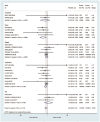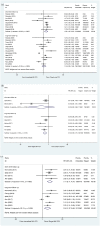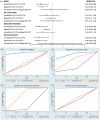The optimal percutaneous coronary intervention strategy for patients with ST-segment elevation myocardial infarction and multivessel disease: a pairwise and network meta-analysis
- PMID: 35295615
- PMCID: PMC8918769
- DOI: 10.1177/20406223221078088
The optimal percutaneous coronary intervention strategy for patients with ST-segment elevation myocardial infarction and multivessel disease: a pairwise and network meta-analysis
Abstract
Objective: To investigate the optimal percutaneous coronary intervention (PCI) strategy in patients with ST-segment elevation myocardial infarction (STEMI) and multivessel coronary artery disease.
Methods: Trials that randomized patients with STEMI and multivessel coronary artery disease to immediate multivessel PCI, staged multivessel PCI, or culprit-only PCI and prospective observational studies that investigated all-cause death were included. Random effect risk ratio (RR) and 95% confidence interval (CI) were calculated.
Results: A total of 13 randomized trials with 7627 patients and 21 prospective observational studies with 60311 patients were included. In the pairwise and network meta-analysis based on randomized trials, immediate or staged multivessel PCI was associated with a lower risk of long-term major adverse cardiac events (MACE; RR: 0.58; 95% CI: 0.45 to 0.74) than culprit-only PCI, which was mainly due to lower risks of myocardial infarction (RR: 0.67; 95% CI: 0.51 to 0.88) and revascularization (RR: 0.38; 95% CI: 0.28 to 0.51), without any significant difference in all-cause death (RR: 0.85; 95% CI: 0.69 to 1.04; I 2 = 0.0%). However, short-term outcomes were deficient in randomized trials. The results from real-world prospective observational studies suggested that staged multivessel PCI reduced long-term all-cause death (RR: 0.53; 95% CI: 0.39 to 0.71; I 2 = 15.6%), whereas immediate multivessel PCI increased short-term all-cause death (RR: 1.58; 95% CI: 1.22 to 2.05; I 2 = 43.8%) relative to culprit-only PCI.
Conclusion: For patients in randomized trials, multivessel PCI in an immediate or staged procedure was preferred due to improvements in long-term outcomes. As a supplement, the results in real-world patients derived from prospective observational studies suggested that staged multivessel PCI was superior to immediate multivessel PCI. Therefore, staged multivessel PCI may be the optimal PCI strategy for patients with STEMI and multivessel coronary artery disease.
Keywords: ST-segment elevation myocardial infarction; multivessel disease; multivessel revascularization; network meta-analysis; percutaneous coronary intervention.
© The Author(s), 2022.
Conflict of interest statement
Conflict of interest statement: The authors declared no potential conflicts of interest with respect to the research, authorship and/or publication of this article.
Figures






Similar articles
-
Immediate Versus Staged Multivessel PCI Strategies in Patients with ST-Segment Elevation Myocardial Infarction and Multivessel Disease: A Systematic Review and Meta-Analysis.Am J Med Sci. 2022 Feb;363(2):161-173. doi: 10.1016/j.amjms.2021.06.017. Epub 2021 Jul 15. Am J Med Sci. 2022. PMID: 34274323
-
Multivessel Versus Culprit-Only Revascularization in STEMI and Multivessel Coronary Artery Disease: Meta-Analysis of Randomized Trials.JACC Cardiovasc Interv. 2020 Jul 13;13(13):1571-1582. doi: 10.1016/j.jcin.2020.04.055. JACC Cardiovasc Interv. 2020. PMID: 32646699
-
Does multivessel revascularization fit all patients with STEMI and multivessel coronary artery disease? A systematic review and meta-analysis.Int J Cardiol Heart Vasc. 2021 Jun 11;35:100813. doi: 10.1016/j.ijcha.2021.100813. eCollection 2021 Aug. Int J Cardiol Heart Vasc. 2021. PMID: 34169144 Free PMC article. Review.
-
The optimal timing for intervention in patients with ST-segment elevation myocardial infarction and multivessel disease: a systematic review and meta-analysis.Front Cardiovasc Med. 2024 Aug 9;11:1389017. doi: 10.3389/fcvm.2024.1389017. eCollection 2024. Front Cardiovasc Med. 2024. PMID: 39185134 Free PMC article.
-
Meta-Analysis of Culprit-Only Versus Multivessel Percutaneous Coronary Intervention in Patients With ST-Segment Elevation Myocardial Infarction and Multivessel Coronary Disease.Am J Cardiol. 2018 Mar 1;121(5):529-536. doi: 10.1016/j.amjcard.2017.11.022. Epub 2017 Dec 12. Am J Cardiol. 2018. PMID: 29304995
Cited by
-
Top Five Stories of the Cellular Landscape and Therapies of Atherosclerosis: Current Knowledge and Future Perspectives.Curr Med Sci. 2024 Feb;44(1):1-27. doi: 10.1007/s11596-023-2818-2. Epub 2023 Dec 7. Curr Med Sci. 2024. PMID: 38057537 Review.
References
-
- Widimsky P, Budesinsky T, Vorac D, et al.. Long distance transport for primary angioplasty vs immediate thrombolysis in acute myocardial infarction. Final results of the randomized national multicentre trial – PRAGUE-2. Eur Heart J 2003; 24: 94–104. - PubMed
-
- Moreno R, García E, Elízaga J, et al.. Results of primary angioplasty in patients with multivessel disease. Rev Esp Cardiol 1998; 51: 547–555. - PubMed
-
- Iqbal MB, Nadra IJ, Ding L, et al.. Culprit vessel versus multivessel versus in-hospital staged intervention for patients with ST-segment elevation myocardial infarction and multivessel disease: stratified analyses in high-risk patient groups and anatomic subsets of nonculprit disease. JACC Cardiovasc Interv 2017; 10: 11–23. - PubMed
-
- Vlaar PJ, Mahmoud KD, Holmes DR, Jr, et al.. Culprit vessel only versus multivessel and staged percutaneous coronary intervention for multivessel disease in patients presenting with ST-segment elevation myocardial infarction: a pairwise and network meta-analysis. J Am Coll Cardiol 2011; 58: 692–703. - PubMed
-
- Wald DS, Morris JK, Wald NJ, et al.. Randomized trial of preventive angioplasty in myocardial infarction. N Engl J Med 2013; 369: 1115–1123. - PubMed
LinkOut - more resources
Full Text Sources
Research Materials
Miscellaneous

